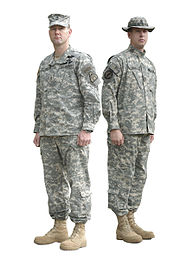Weapons


The Army employs various individual weapons to provide light firepower at short ranges.
The M16 series assault rifle[23] and its compact variant, the M4 carbine,[24] which is slowly replacing selected M16 series rifles in some units and is primarily used by infantry, Ranger, and Special Operations forces.[25] Soldiers whose duties require a more compact weapon, such as combat vehicle crew members, staff officers, and military police, are issued a sidearm in lieu of a rifle. The most common sidearm in the U.S. Army is the 9 mm M9 pistol[26] which is issued to the majority of combat and support units.
Many combat units' arsenals are supplemented with a variety of specialized weapons, including the M249 light machine-gun, to provide suppressive fire at the fire-team level,[27] the M1014 Joint Service Combat Shotgun or the Mossberg 590 Shotgun for door breaching and close-quarters combat, the M14 rifle for long-range marksmen, and the M107 Long Range Sniper Rifle, the M24 Sniper Weapon System, or the M110 Semi-Automatic Sniper Rifle for snipers. Hand grenades, such as the M67 fragmentation grenade and M18 smoke grenade, are also used by combat troops.
The Army employs various crew-served weapons to provide heavy firepower at ranges exceeding that of individual weapons.
The M249 is the Army's standard light machine gun. The M240 is the Army's standard medium machine gun.]. The 12.7 mm M2 heavy machine gun is used as an anti-material and anti-personnel machine gun. The M2 is also the primary weapon on most Stryker variants and the secondary weapon system on the M1 Abrams. The 40 mm MK 19 grenade machine gun is mainly used by motorized units.[ It is commonly employed in a complementary role to the M2.
The Army uses three types of mortar for indirect fire support when heavier artillery may not be appropriate or available. The smallest of these is the 60 mm M224, normally assigned at the infantry company level. At the next higher echelon, infantry battalions are typically supported by a section of 81 mm M252 mortars. The largest mortar in the Army's inventory is the 120 mm M120/M121, usually employed by mechanized battalions, Stryker units, and cavalry troops because its size and weight require it to be transported in a tracked carrier or towed behind a truck.
Fire support for light infantry units is provided by towed howitzers, including the 105 mm M119A1[33] and the 155 mm M777 (which will replace the M198).[34]
Vehicles

The U.S. Army spends a sizable portion of its military budget to maintain a diverse inventory of vehicles.
The Army's most common vehicle is the HMMWV, which is capable of serving as a cargo/troop carrier, weapons platform, and ambulance, among many other roles.[35] The M1A2 Abrams is the Army's primary main battle tank,[36] while the M2A3 Bradley is the standard infantry fighting vehicle.[37] Other vehicles include the M3A3 cavalry fighting vehicle, the Stryker,[38] and the M113 armored personnel carrier,[39] and multiple types of Mine Resistant Ambush Protected (MRAP) vehicles.
The U.S. Army's principal artillery weapons are the AN/TWQ-1 Avenger, LAV-AD and the M109A6 Paladin self-propelled howitzer[ and the M270 Multiple Launch Rocket System (MLRS),[41] both mounted on tracked platforms and assigned to heavy mechanized units.
While the U.S. Army operates a few fixed-wing aircraft, it mainly operates several types of rotary-wing aircraft. These include the AH-64 Apache attack helicopter,[42] the OH-58D Kiowa Warrior armed reconnaissance/light attack helicopter,[the UH-60 Black Hawk utility tactical transport helicopter, and the CH-47 Chinook heavy-lift transport helicopter.
Uniforms


The Army Combat Uniform (ACU), which features a digital camouflage pattern and is designed for use in woodland, desert, and urban environments.
The standard garrison service uniform is known as "Army Greens" or "Class-As" and has been worn by all officers and enlisted personnel since its introduction in 1956 when it replaced earlier olive drab (OD) and khaki (and tan worsted or TW) uniforms worn between the 1980s and 1985. The "Army Blue" uniform, dating back to the mid-19th century, is currently the Army's formal dress uniform, but in 2009, it will replace the Army Green and the Army White uniforms (a uniform similar to the Army Green uniform, but worn in tropical postings) and will become the "new" Army Service Uniform, which will function as both a garrison uniform (when worn with a white shirt and necktie) and a dress uniform (when worn with a white shirt and either a necktie for parades or a bow tie for "after six" or "black tie" events). The beret will continue to be worn with the new ACU for garrison duty and with the Army Service Uniform for non-ceremonial functions. The Army Blue Service Cap, formerly allowed for wear by all enlisted personnel, are now only allowed for wear by any soldier ranked CPL or above at the discretion of the commander.
Body armor in all units is the Improved Outer Tactical Vest, which is now being supplemented with a lightweight Modular Body Armor Vest.


No comments:
Post a Comment